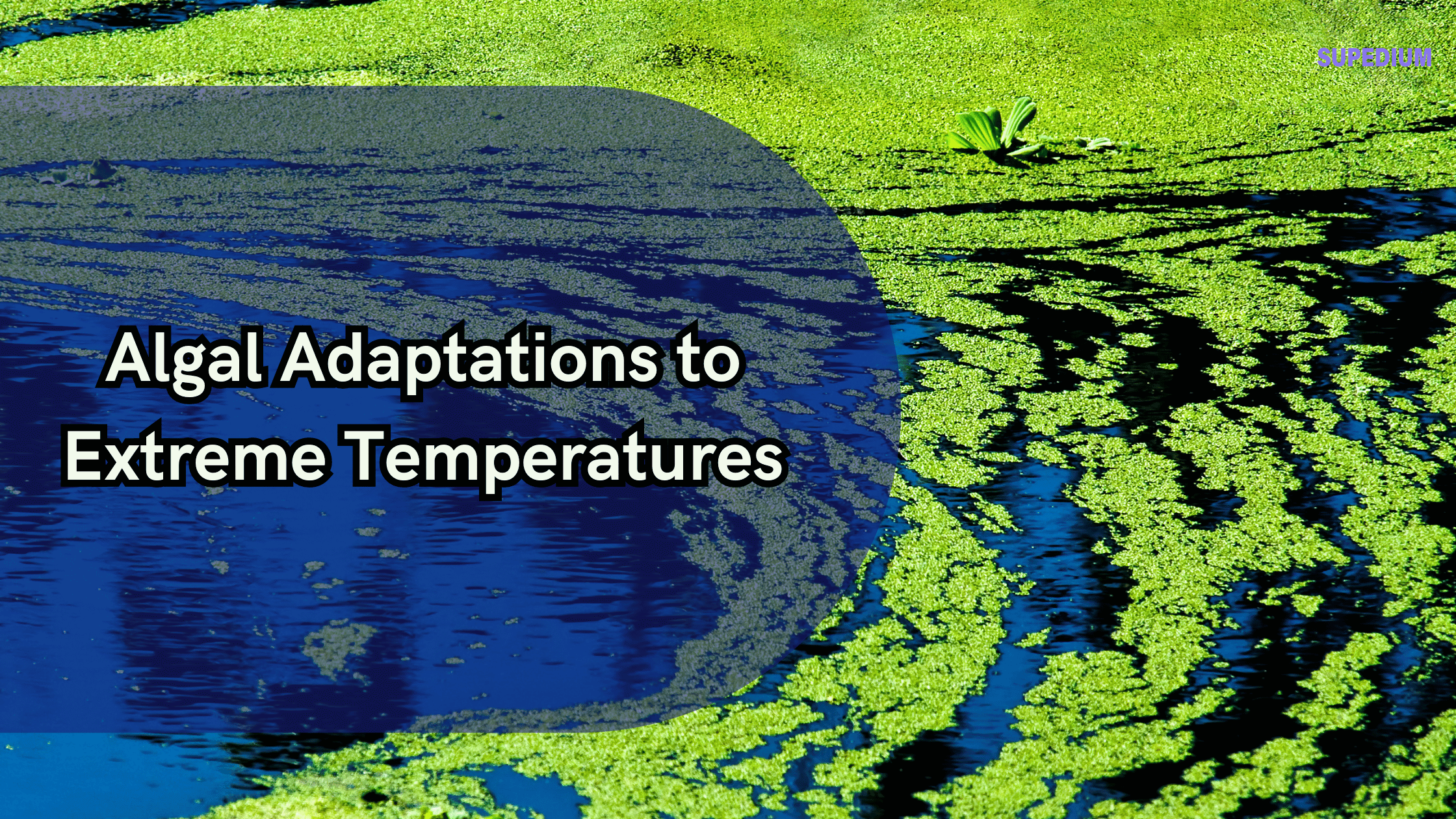Table of Contents
![]()
Algae, a diverse group of photosynthetic organisms, play crucial roles in a variety of ecosystems, from freshwater lakes to the open ocean. They are not only important for their ecological functions but also have significant economic and biotechnological applications. Studying how algae adapt to extreme temperatures—whether hot or cold—can provide insights into their resilience, evolutionary strategies, and potential uses in biotechnology and environmental management.
Types of Extreme Temperature Environments
Extreme temperature environments can be broadly categorized into hot and cold environments.
Hot Environments: These include thermal springs, hot deserts, and other areas with high temperatures. For example, thermal springs such as those in Yellowstone National Park and the Atacama Desert in Chile are characterized by temperatures that can exceed 70°C (158°F). These environments challenge organisms to withstand not only high temperatures but also significant fluctuations in thermal conditions.
Cold Environments: These encompass polar ice caps, high-altitude regions, and other areas where temperatures can drop significantly below freezing. For instance, the Antarctic ice sheets and the Arctic tundra present extreme cold, with temperatures plunging below -40°C (-40°F). Algae in these environments must survive prolonged periods of freezing and low temperatures.
General Mechanisms of Temperature Adaptation
Algae employ various mechanisms to adapt to extreme temperatures, which can be broadly categorized into physiological adjustments and structural adaptations.
Physiological Adjustments:
- Temperature-Induced Metabolic Changes: Algae adjust their metabolic processes to cope with extreme temperatures. In hot environments, they may increase the synthesis of heat shock proteins that help maintain cellular functions. Conversely, in cold environments, they produce cold shock proteins and other cryoprotective substances to prevent damage from freezing temperatures.
- Regulation of Enzyme Activity: Enzymes in algae are adapted to function optimally at their respective temperature extremes. Heat-adapted enzymes in thermophilic algae remain stable and functional at high temperatures, while cold-adapted enzymes in psychrophilic algae are active at low temperatures.
Structural Adaptations:
- Cell Membrane Fluidity: Algae modify their cell membrane compositions to maintain fluidity. In hot environments, they increase the proportion of saturated fatty acids to stabilize membranes, while in cold environments, they incorporate unsaturated fatty acids to prevent membrane rigidity.
- Protective Compounds: Algae produce various protective compounds, such as heat shock proteins and antifreeze proteins. These molecules help protect cellular structures and functions from extreme temperatures.
Adaptations to Hot Environments
Thermotolerance Mechanisms:
- Heat Shock Proteins and Molecular Chaperones: Thermophilic algae, such as those found in thermal springs, produce heat shock proteins that aid in protein folding and prevent denaturation. These proteins help the algae survive and thrive in high-temperature environments.
- Heat-Stable Pigments and Secondary Metabolites: Some algae synthesize heat-stable pigments and other secondary metabolites that protect against thermal stress and oxidative damage.
Cellular and Metabolic Adjustments:
- Altered Photosynthetic Pathways: In hot environments, algae may alter their photosynthetic pathways to optimize energy production and minimize heat damage. For example, some algae employ alternative electron transport mechanisms to dissipate excess energy safely.
- Osmotic Regulation and Ion Balance: Thermophilic algae often adjust their internal osmotic balance by synthesizing compatible solutes like glycerol, which helps stabilize cellular structures and maintain ion balance under thermal stress.
Examples of Thermophilic Algae:
- Thermus aquaticus: This bacterium, although not an alga, is often studied for its heat-stable enzyme, Taq polymerase, which is used in PCR (polymerase chain reaction). Similar thermophilic algae have enzymes adapted to high temperatures.
- Cyanobacteria in Hot Springs: Certain cyanobacteria, such as those in Yellowstone’s hot springs, are adapted to extreme temperatures and are studied for their unique metabolic processes.
Adaptations to Cold Environments
Psychrotolerance Mechanisms:
- Cold Shock Proteins and Cryoprotectants: Psychrophilic algae, found in polar and high-altitude regions, produce cold shock proteins that protect cellular machinery from low temperatures. They also synthesize cryoprotectants, such as glycerol, to prevent ice crystal formation within cells.
- Maintenance of Membrane Fluidity: To remain functional at low temperatures, cold-adapted algae alter the lipid composition of their cell membranes, incorporating more unsaturated fatty acids to maintain fluidity and functionality.
Cellular and Metabolic Adjustments:
- Altered Photosynthetic Efficiency: Cold-adapted algae often modify their photosynthetic processes to optimize light absorption and energy conversion in low-temperature environments.
- Accumulation of Compatible Solutes: Similar to their hot-environment counterparts, psychrophilic algae accumulate compatible solutes, such as glycerol, to stabilize cellular structures and protect against freeze-induced damage.
Examples of Psychrophilic Algae:
- Chlamydomonas nivalis: This green alga, found in snowfields, produces a red pigment that helps absorb light and protect against UV radiation in cold, high-altitude environments.
- Antarctic Algae: Algae in the Antarctic region have adapted to survive extreme cold by producing unique cryoprotective proteins and modifying their metabolic pathways to thrive in icy conditions.
Molecular and Genetic Basis of Temperature Adaptations
Gene Expression and Regulation:
- Heat Shock and Cold Shock Response Genes: Algae regulate the expression of specific genes in response to temperature changes. Heat shock response genes are activated under high temperatures, while cold shock response genes are upregulated at low temperatures. These genes encode proteins that help manage stress and maintain cellular integrity.
Genomic Studies and Genetic Engineering:
- Insights from Genome Sequencing: Advances in genome sequencing have provided insights into the genetic basis of temperature adaptations in algae. Researchers can identify genes involved in stress responses and explore their functions.
- Applications in Biotechnology: Understanding the genetic mechanisms behind temperature tolerance can lead to applications in biotechnology, such as engineering algae with enhanced resilience for industrial processes or environmental applications.
Ecological Implications and Applications
Impact on Ecosystem Dynamics:
- Role in Extremophilic Ecosystems: Temperature-adapted algae are integral to extremophilic ecosystems, contributing to primary production, nutrient cycling, and habitat formation. Their ability to survive and function in extreme environments supports the overall stability of these ecosystems.
- Influence on Food Webs: Algae serve as a primary food source for various organisms in extreme environments. Their adaptations ensure that they can continue to provide essential nutrients to higher trophic levels.
Practical Applications:
- Biotechnological Uses: Temperature-adapted algae have potential applications in biotechnology, including the production of biofuels, pharmaceuticals, and other valuable compounds. Their unique metabolic pathways and stress responses make them valuable for industrial processes.
- Environmental Monitoring: Algae are used as indicators of environmental changes, including climate change. Studying their adaptations helps monitor the impacts of temperature fluctuations on ecosystems and provides insights into future environmental changes.
Future Research Directions
Emerging Technologies and Methods:
- Advanced Genomic and Proteomic Techniques: New technologies in genomics and proteomics are providing deeper insights into the molecular mechanisms of temperature adaptation in algae. Techniques such as CRISPR and high-throughput sequencing are advancing our understanding of these processes.
Gaps in Current Knowledge:
- Long-Term Evolutionary Adaptations: More research is needed to understand the long-term evolutionary adaptations of algae to extreme temperatures. This includes studying their evolutionary history and how they have adapted over geological timescales.
- Modeling Temperature Responses: Improved models are needed to predict how algae will respond to future temperature changes. This includes incorporating data from laboratory studies and field observations to create accurate predictive models.
Conclusion
Algae exhibit remarkable adaptations to extreme temperatures, whether in hot springs or freezing polar regions. Their ability to survive and function in these harsh environments is a testament to their resilience and evolutionary ingenuity. Understanding these adaptations not only sheds light on the fundamental biology of algae but also has important implications for biotechnology and environmental management. Continued research into algal temperature adaptations promises to enhance our knowledge of extremophiles and their potential applications in various fields.
Share This





Be the first to comment